Everything in this flower is fascinating: both smooth shiny rich green leaves and amazing snow-white terry flowers, as if made from wax. The stunning aroma of jasmine makes you remember the summer. This tropical guest is a big sissy. Caring for jasmine gardenia at home is quite complicated. For successful growth and flowering, it is necessary to fulfill many of the requirements that this capricious beauty makes.
Material Content:
Gardenia jasmine: features of cultivation

Difficulties begin after the purchase. Unlike many other indoor plants, gardenia, purchased in a store, will immediately require a new pot and specially selected soil.
Transplant after purchase
Peat soils in which this flower grows in a store are not suitable for it. Often a plant braids its roots around the entire earthen lump and does not have the ability to fully develop - a pot in which it grows very small. Therefore, a transplant is the first thing to do after buying a gardenia. But first, you should arrange a tropical sissy with a warm shower. After a few days needed to adapt the flower, you can begin to transplant it.
Soil requirements
This plant has a lot of them.
- Earth must have an acid reaction. You can purchase a special soil intended for plants - acidophils: azaleas, rhododendrons.
- Soil should dry quickly and retain moisture well.For looseness, sand, perlite, processed and crushed moss-sphagnum, which is able to acidify the earth, are used.
- The soil should contain enough nutrients.
If there is no way to buy ready-made soil, you can prepare it yourself.
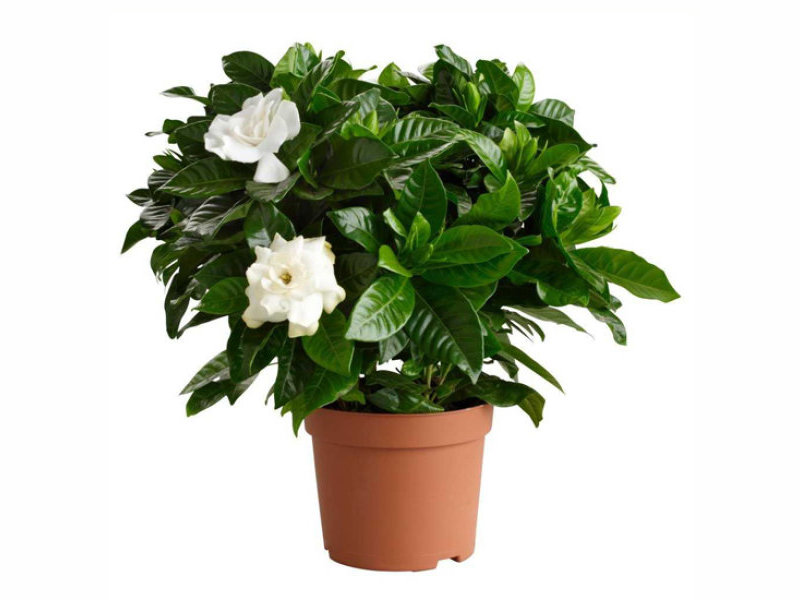
The following mixture is suitable, all components of which are taken in equal parts:
- turf land;
- coniferous soil;
- high peat;
- sheet earth;
- sand.
When the soil mixture is prepared, proceed to the transplant.
- We prepare the growth stimulator solution according to the instructions, but we dilute it only in warm soft water.
- An hour before transplanting, water the gardenia with warm soft water. Carefully remove the plant from the pot without damaging the roots.
- If rot is found on them, we remove all diseased roots, soak the earthen lump for 20 minutes in a slightly pink solution of potassium permanganate. After that, we place the root system in a solution of the root stimulant. You can just dust the roots of the plant with a dry powder.
- While it is soaking, prepare a pot for planting. It should be slightly larger than the one in which the gardenia was brought from the store. Ideally, between the walls of the pot and the earthen lump should be about 1.5 cm. We lay a drainage layer of expanded clay or small stones at the bottom, put a layer of sand on top, a little soil mixture on it.
- We take out the plant from the root-forming solution and, if there are several of them in one pot, carefully separate them. Each bush needs a separate pot.
- We place the azalea in the center of the pot and sprinkle it with soil, compacting it a little.
- Water the remaining solution.
Read also:home care for yucca
Nuances
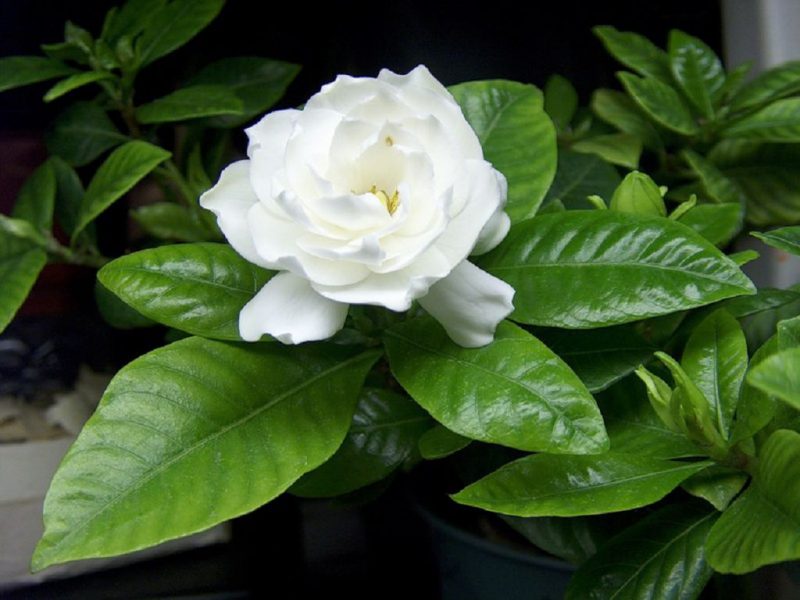
All soil components, as well as drainage elements must be steamed. When transplanting, make sure that the roots of the azalea do not come in contact with the drainage layer. The plant should be strictly in the center of the pot, the distance from its roots to the walls should be the same. After planting, the plant needs to be sprayed with epin to reduce stress. The transplanted gardenia is placed in a warm place with diffused light for several days. When she comes to life after a transplant, they choose her permanent place of residence.
Gardenia can not be transplanted in a flowering state - it will drop flowers, so you have to wait until the flowering ends.
Gardenia jasmine: care
A jasmine-shaped gardenia houseplant requires close attention. At the slightest violation of the conditions of detention, she can lose not only flowers, but also leaves. Everything is important: temperature, air humidity, timely and proper watering and top dressing, lighting.
Temperature, humidity and lighting
These are the three most important components for plant health and its abundant flowering.
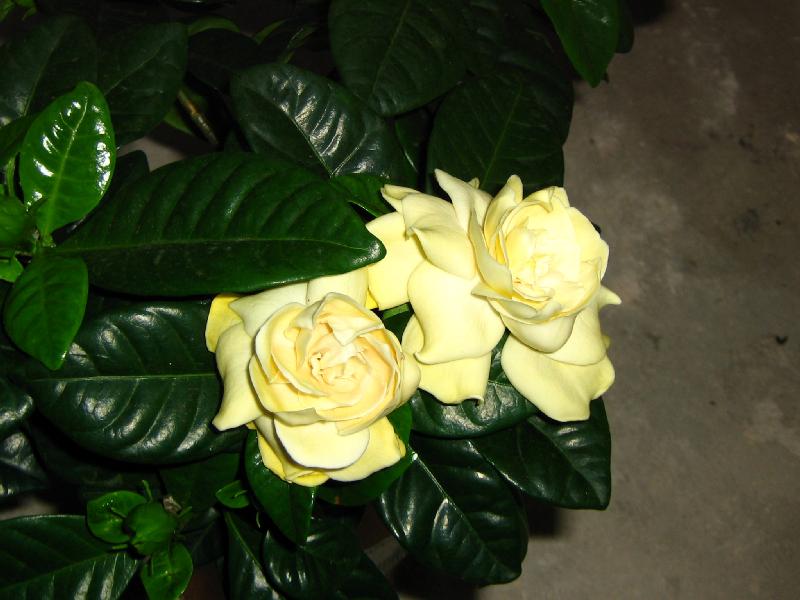
- The constancy of temperature is very important for this flower, in the summer we maintain it within 21-24 degrees during the day and 15-18 degrees at night. In winter, it must be reduced to 16 degrees. At low temperatures, in conditions of lack of light, the plant will be less depleted. At higher winter temperatures, gardenia begins to grow new shoots, and bloom will be less. Drafts where gardenia is contained are unacceptable - this creates stress for the plant.
- This whim grows well in bright light. But the bright sun in the summer is harmful to her. The flower will be most comfortable on the windowsills of windows with a western or south-western orientation. In winter, tropical sissy should be lit to the maximum.
A place for a flower you need to choose a permanent. It can not only be rearranged, but even slightly moved the pot, especially when the gardenia blooms.
Like all people in the tropics, gardenia loves high humidity, especially during flowering. It can be humidified by spraying, but excluding water droplets falling on the flowers - spots remain on them. For spraying, soft water, having a room temperature, is suitable. You can put an evaporator next to the plant or place it in a pan with wet pebbles.It is good to arrange a warm shower for the sissy, covering the soil in the pot with a film so that it does not get wet. You can wipe the leaves of the flower with a damp cloth.
Watering a plant
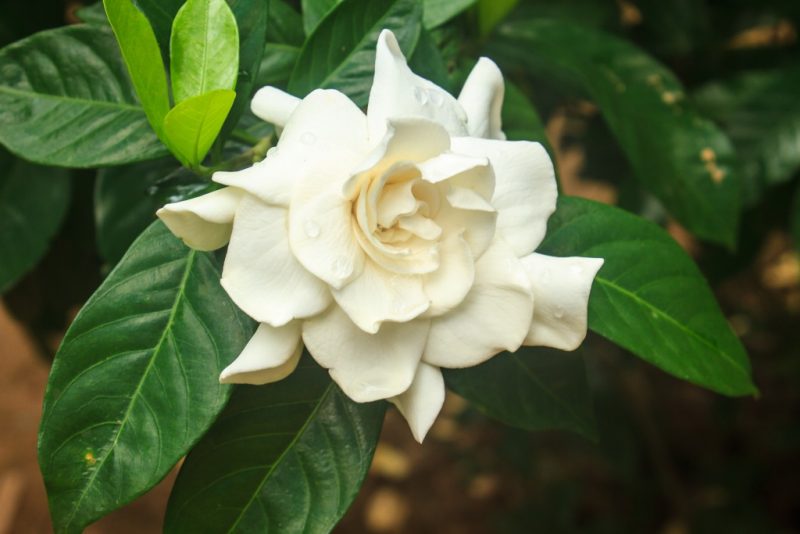
Proper watering will ensure a long and lush flowering gardenia. In summer, the earth in the pot should always be moist, so watering is carried out regularly. In winter it is permissible to do this a little less often - once every 2-3 days. But in any season, the water should be soft, better boiled, not contain salts. The temperature of the irrigation water should not be lower than room temperature or slightly warmer. Every fifth watering is acidified by adding 2-3 drops of lemon juice per liter of water. You can insist water on peat. Water the bush only from above, it is impossible to water through the pan. Excessive humidity harms room beauty - it provokes the development of root rot.
Fertilizer and fertilizer
Gardenia top dressing has its own characteristics. The first top dressing is carried out in 1-2 months after transplantation. Plants brought from Holland do not feed the entire first season, as their soil is well seasoned with nutrients, overfeeding this plant is harmful.
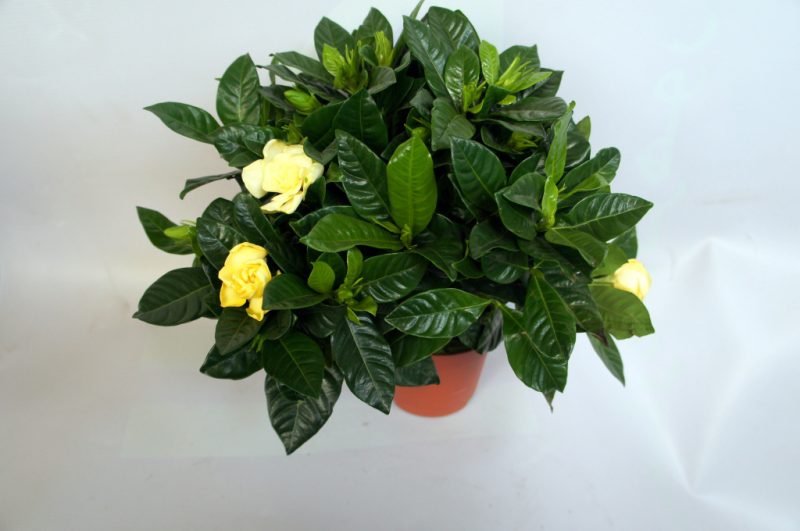
Root dressing is done with acid complex fertilizers designed for azaleas, but their concentration is reduced by 2 times. Every decade they feed the entire season of active growth. Once a week, you can do foliar dressing with a weak solution of the same fertilizer. Mineral fertilizing is combined with organic - special liquid preparations for indoor flowers. In winter, the amount of top dressing is reduced or completely stopped if the plant does not bloom.
In order to prevent chlorosis, a couple of times a season the gardenia is fed with iron chelate. You can spray them with plants on the leaves. The problem of iron deficiency can be solved by digging a few rusty nails into a pot.
Rules for care after flowering
When the gardenia has faded, the most suitable time for trimming and shaping it. Twigs are cut in half or 2/3 of the length. Remove dried or interfering shoots. Cropped healthy twigs can be used as cuttings for rooting.
Gardenia propagation
It is easiest to carry out with semi-lignified cuttings. They are kept for half an hour in a weak solution of potassium permanganate. Then it is planted in a substrate from a mixture of sand and peat and covered with a glass jar. It must sometimes be removed to ventilate the cuttings. The soil must be moist. Cuttings take root well if lower soil heating is applied. Rooted plants are planted in separate containers. With a shoot height of 15 cm, pinch it for better tillering.
How to grow jasmine gardenia from seeds?
The seeds of this plant are rapidly losing germination, so they need to be sown 2-3 days after harvest. To increase germination, seeds are treated with zircon solution or aloe juice, soaking them for 3-4 hours.
Sow seeds in moistened and previously disinfected soil for azaleas, sprinkled with a layer of soil with a thickness of 5 mm. Put a plastic bag on the container with seeds, or cover it with glass. The bag or glass is removed from time to time for ventilation. The soil is sprayed from the spray gun. Shoots appear in a month. All this time the container is kept warm and dark. After emergence, it is transferred to a windowsill with diffused light. The grown seedlings are planted and pinched. Growing jasmine gardenia from seeds is best done in spring.
Pests and diseases and methods of dealing with them
A painful state of gardenia is often associated with errors in care. Sometimes it is due to the appearance of pests.
Table: main diseases and gardenia pests.
| Signs of defeat | What caused | How do they manifest | Control measures |
|---|---|---|---|
| Flower buds fall | Air humidity below normal | Buds fall before opening | Increasing air humidity by spraying and placing the pot on a wet pebble pan |
| Stains on flowers | Water falling on flowers through careless spraying | The appearance of brown spots on the petals | Replacing spraying with other methods of humidification |
| Yellowing leaves | Chlorosis due to iron deficiency | Leaves turn yellow, but veins remain green | Feeding with iron chelate by pouring lime-free water |
| Leaf blackening | Sooty fungus caused by pests | Black soot film on leaves | Pest control, plant washing |
| White woolly spots | Mealybug | The appearance of white spots from the inside of the sheet | The use of insecticides, rubbing leaves with alcohol |
| Pale yellow leaves | Spider mite | Punctures on the leaves are visible in the light, a thin cobweb is visible from the inside of the sheet | Acaricide or Acaroinsecticide Treatment |
| Leaf discoloration | Shield | The appearance of brown scaly insects from the inside of the leaf | Insecticide treatment or rubbing leaves with alcohol |
The main problems when growing plants
Gardenia is very capricious and demanding compliance with all the rules of care. If you break them, she will immediately respond by dropping buds or changing the color of the leaves.
The leaves turn black and fall
The leaves turn black and fall if the root system of the plant does not work well.

To eliminate this cause, you need to check the following:
- whether the soil passes air well, is it not compacted;
- whether the drainage holes are clogged - this can lead to stagnation of water and decay and weakening of the root system;
- whether there is overfeeding in plants - excess fertilizer depresses the roots.
The black tip is a signal about the appearance of pests that infected the plant with viral or bacterial diseases.
Yellowing leaves

If the lower tier is yellow, the cause may be excessive humidity or a draft in the room. The upper layer turns yellow - the acidity of the soil is not normal, which complicates the assimilation of nitrogen. If all the leaves turn yellow - the plant has populated a spider mite or it lacks either nitrogen or iron. You need to restore balance gradually, otherwise you can harm the flower.
Despite all the vagaries, this charming inhabitant of the tropics can decorate every home. It is simply impossible to look away from amazing flowers, and the amazing smell will create a special aura in the house.












